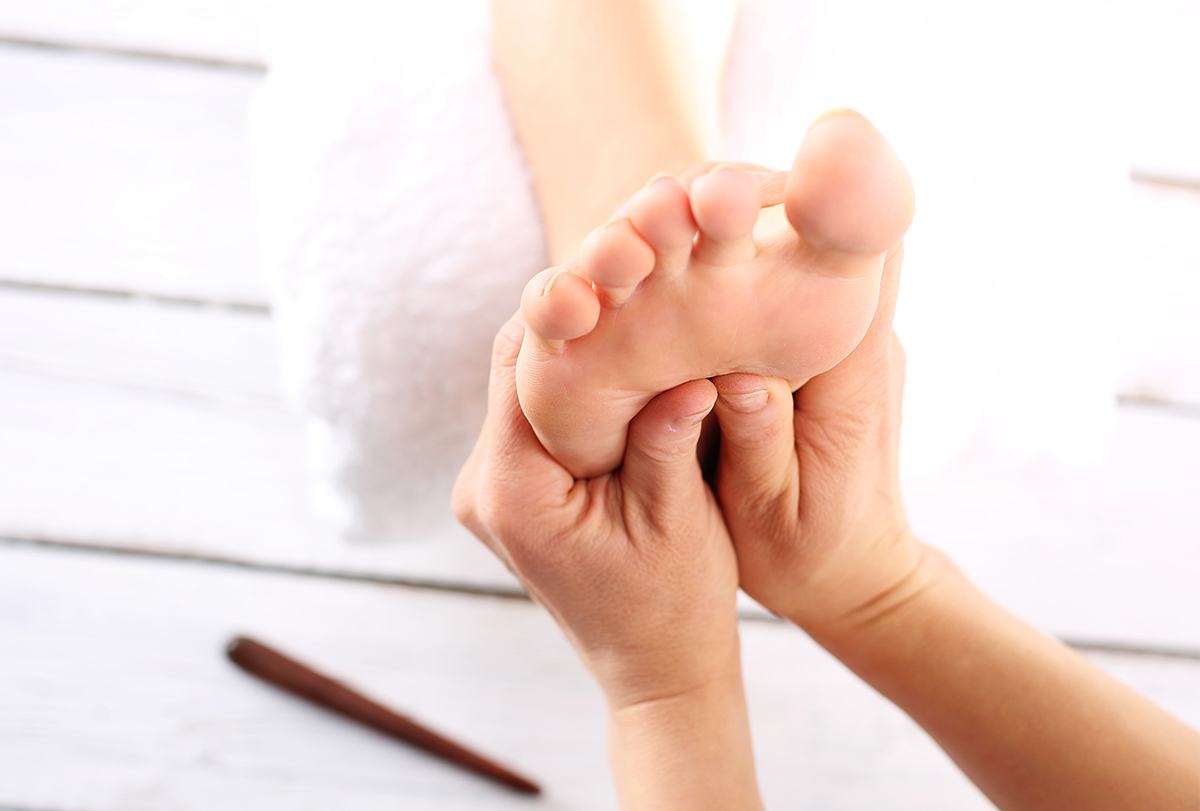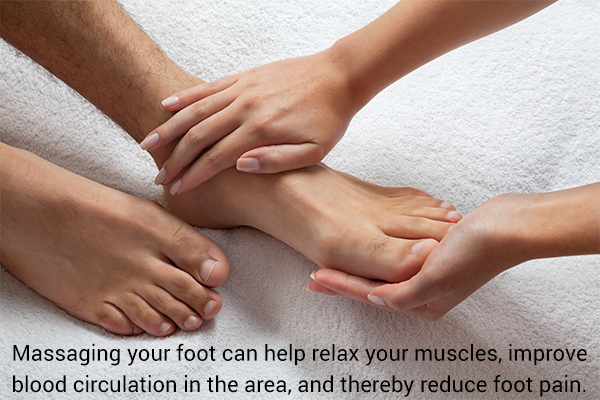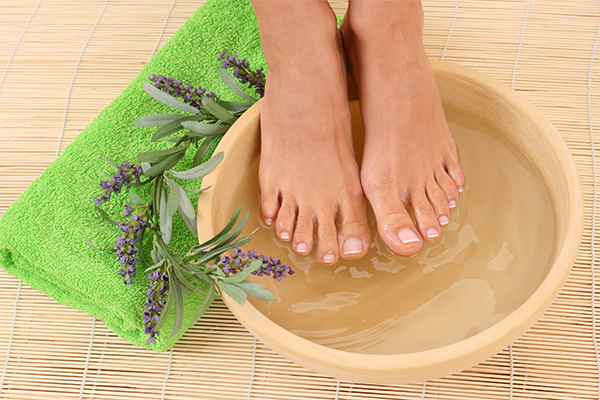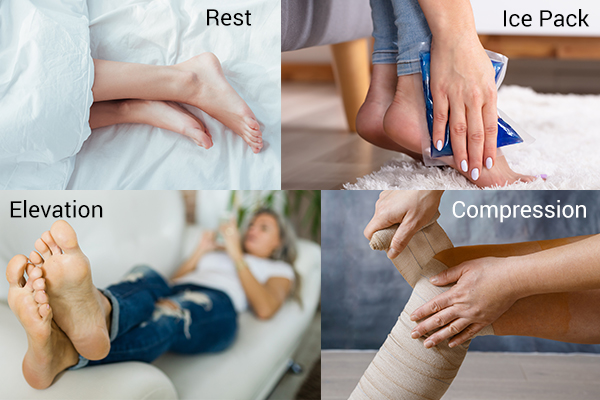In this article:
Foot pain is a common problem that often limits your mobility and causes difficulty in walking, thus interfering with your daily activities. Therefore, it is vital to take good care of your foot to avoid any discomfort.

Home Remedies for Foot Pain
It is necessary to take proper care of your feet to help alleviate or prevent foot pain or any associated problems.
1. Massage your foot

This helps reduce tension, improve circulation, stimulate muscles, and reduce pain. In one study, foot massage aided postoperative pain and anxiety reduction in patients undergoing laparoscopic surgery. (2)
2. Manage your weight
Excess weight puts additional stress on your feet. Therefore, losing some weight can help relieve pressure and pain.
3. Exercise
Exercise helps strengthen your feet and lower extremities. You may try non-weight-bearing activities, such as swimming if you experience pain while exercising.
A study demonstrated that strengthening and stretching exercises aided in the improvement of gait and pain reduction in patients with plantar fasciitis. (3)
For relief from foot cramps:
- Sit down and straighten your leg. Hold the foot and pull it toward you.
- Alternatively, loop a towel around your foot for pulling if you cannot reach it by hand.
- Exercises for gently stretching the Achilles tendon or plantar fascia can help reduce the pain.
4. Switch your footwear
Wear comfortable, wide-toed, fit shoes with arch support and proper cushioning. Use sneakers for walking and replace your running shoes frequently.
5. Keep your feet clean
Wash your feet regularly and check for ingrown toenails, infections, and other issues.
6. Moisturize your feet
Apply a lotion or cream after washing your feet to prevent corns. You may need to moisturize your feet multiple times a day during dry winter months.
7. Trim calluses and corns
The hard and dry skin of corns and calluses can put excess pressure on the foot sole, often causing bleeding, cracks, and infection.
To trim calluses and corns:
- Immerse your feet in warm water for some time.
- Rub a pumice stone or emery board to remove the dead skin cells after drying your feet.
- Apply a lotion to hydrate the skin and wear socks to lock in the moisture.
8. Use padding
Protect a callus by placing two pieces of half-moon-shaped moleskin around it. Additionally, use donut-shaped adhesive pads to prevent your corn from touching the shoes. These products are readily available at drugstores.
9. Walk properly
Although foot problems can create difficulty in walking and other activities, it is important to maintain your posture and gait to prevent further joint, foot, or back problems.
10. Soak your feet in an Epsom salt bath

Epsom salt has been popularized as a natural muscle relaxant and analgesic which is safe for external use. It is widely used as a bath salt and in foot soaks wherein it disintegrates into its chief components, i.e. magnesium and sulfate.
Experts suggest that these minerals then seep into your body through the skin after prolonged immersion and act upon the underlying source of pain and inflammation.
To make the foot bath even more effective, make sure to use warm water, which can help open up your skin pores, loosen the tight muscles, and improve blood circulation.
How to use: Simply add 1 or 2 cups of Epsom salt to a tub or bucket of warm water (not too hot) and dip your feet in it for about 15 minutes.
11. Try essential oils
You can fix yourself a relaxing bath by adding the following therapeutic essential oils to your bathwater:
- Lavender oil has shown anti-inflammatory effects, but further studies are needed in this regard. (4) There is still a need for further research in this area.
- Eucalyptus oil has reportedly shown positive results in reducing foot pain, swelling, and inflammation. (5)
- Rosemary oil can help decrease the severity and frequency of foot pain. (6)
How to use: These essential oils can be used in water for soaking, aromatherapy, as well as massage.
First-Line Treatment for Foot Pain
Foot pain triggered by a recent injury, trauma, or arthritis flare-up should initially be treated with the RICE technique, which stands for rest, ice, compression, and elevation.
Each step of this regimen addresses various aspects of pain management to provide immediate relief and prevent further damage.

1. Rest
When your foot is already hurting, the first thing you need to do is to give it rest so that the damage doesn’t worsen. Avoid any activities that exert pressure on the foot or aggravate the pain for up to 2 days.
Raise your feet while sitting or lying down to help reduce swelling. If you continue exerting your aching foot, the underlying injury could get exacerbated and result in more severe discomfort that is harder to treat.
2. Ice
Applying an ice pack can temporarily numb the nerve endings in your foot and make you feel less pain. Place a towel on the affected part of the foot and apply ice over it for about 20 minutes to help alleviate the swelling and pain.
Additionally, you can practice ice massage by rolling a frozen can under the foot (in the case of plantar fasciitis, for example) for around 10 minutes, with moderate pressure, daily. (1)
Never apply ice directly to the skin for extended periods as it can induce frostbite.
3. Compression
Applying pressure on the sore foot by strapping a bandage around it can help reduce the pooling of blood and other fluids at the affected site. Make sure that the bandage is tight but not too tight.
4. Elevation
Raising the foot above the heart level reduces the flow of blood and other fluids to the lower extremities and directs them away from the site of injury, which helps bring down swelling.
Additional tip: Remove all jewelry from your foot and ankle to let go off any extra load.
Preventive Steps for Foot Pain
While the specific measures to prevent the recurrence of foot pain depend on its cause, you can make the following lifestyle changes to avoid the development of foot pain:
- Consume a healthy diet.
- Perform moderate exercises daily.
- Maintain a healthy weight.
- Avoid smoking.
- Refrain from excessive alcohol or drug consumption.
- Take adequate rest.
- Avoid high-impact, repetitive motion.
- Avoid prolonged sitting or standing.
- Take measures to keep your blood pressure in check.
- Wear comfortable shoes and clothing.
- Use a rubber mat if you are required to stand for long periods.
Why Does Foot Pain Increase at Night?

Foot pain that aggravates at night may indicate poor circulation, a nerve issue, or an underlying sleep disorder. Please consult your physician for an appropriate evaluation if it is persistent.
For example, while the symptoms of tarsal tunnel syndrome worsen with activities throughout the day and subside with rest, some patients have reported pain during rest as the disease progresses.
Final Word
Most cases of foot pain can be easily alleviated after implementing some self-care measures. While minor injuries can heal on their own or with the help of home remedies, severe injuries may require proper tests and treatment by a medical professional.

- Was this article helpful?
- YES, THANKS!NOT REALLY


